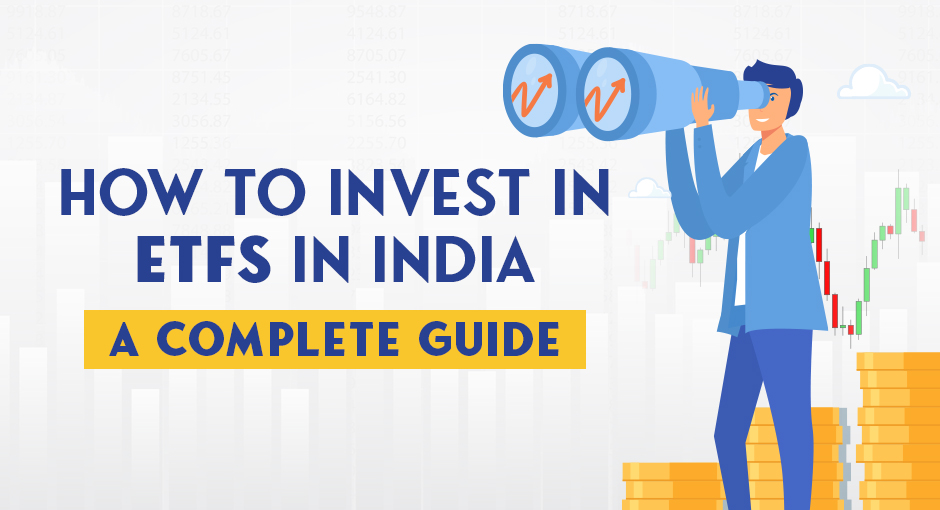
How to Invest in ETFs in India: A Complete Guide
Exchange-Traded Funds (ETFs) are a type of investment that combine the features of stocks and mutual funds. They are collections of securities that trade on the stock market and track the performance of an underlying index, sector, commodity, or currency. ETFs offer investors the benefits of diversification, low cost, liquidity, and transparency. In India, there are various types of ETFs available, such as index ETFs, gold ETFs, sector ETFs, bond ETFs, currency ETFs, and global index ETFs.
Thank you for reading this post, don't forget to subscribe!ETFs are suitable for investors who want to gain exposure to different segments of the market without having to buy individual securities. For example, an ETF that tracks the Nifty 50 Index will hold the same stocks as the index and will move up or down with it. Do you want to diversify your portfolio and reduce your risk? Do you want to save on brokerage fees and taxes? If your answer is yes, then you should consider investing in ETFs.
ETFs offer many benefits to investors as the following:
Diversification
ETFs allow you to invest in a basket of stocks or assets with a single transaction. This reduces your exposure to individual company or market risks and helps you achieve your asset allocation goals.
Low cost
ETFs have lower expense ratios and brokerage fees than buying the stocks individually. You also save on taxes as ETFs are treated as non-equity funds and have lower capital gains tax rates than equity funds.
Liquidity
ETFs are traded on the stock exchange throughout the day and can be bought and sold at any time. You can also use stop-loss orders, limit orders, and margin trading to enhance your trading experience.
Transparency
Most ETFs disclose their holdings and performance frequently in India. You can easily track the performance of your ETFs and compare them with the underlying index or asset. However, some ETFs may disclose less frequently. In India, an example is the Mirae Asset NYSE FANG+ ETF (MIRS), launched in 2020. It tracks the NYSE FANG+ Index of 10 technology and tech-enabled companies. These companies are taken from the technology and consumer discretionary sectors.
However, it’s worth noting that while these benefits generally apply to most ETFs, there can be exceptions or variations depending on specific ETFs, regulatory requirements, and the country in which they are traded. To invest in ETFs, you need a stock broker who can execute your buy and sell orders on the stock exchange. But how do you choose the best equity broker in India for your ETF investments? In this article, we will give you how to carefully review the prospects and documentation before investing in any particular ETF.
How to Compare ETFs with Other Investment Options
ETFs are not the only way to invest in the stock market. There are other investment options such as mutual funds, stocks, bonds, etc., that you can choose from. But how do you compare ETFs with these options and decide which one is best for you? In this section, we will help you answer this question by looking at some of the key factors that differentiate ETFs from other investment options.
Performance
One of the main factors to consider when investing in any option is the performance or the returns that it can generate. ETFs aim to track the performance of a particular index or asset and replicate its returns. For example, if the Nifty 50 Index goes up by 10%, an ETF that tracks it will also go up by 10%. However, this also means that ETFs cannot outperform the index or asset that they track. If the index or asset goes down, the ETF will also go down. Mutual funds, on the other hand, aim to generate alpha by outperforming a market benchmark. They do this by actively selecting and managing a portfolio of stocks or assets based on their research and analysis. For example, if the Nifty 50 Index goes up by 10%, a mutual fund that invests in large-cap stocks may go up by 12% or more by picking the best-performing stocks in the segment.
However, this also means that mutual funds have a higher risk of underperforming the benchmark if their portfolio does not perform well. Stocks and bonds are individual securities that have their own performance and risk characteristics. They can offer higher returns than ETFs or mutual funds if you pick the right ones at the right time. However, they also have higher volatility and risk of loss if you pick the wrong ones or if the market conditions change adversely.
Cost
Another important factor to consider when investing in any option is the cost or the fees that you have to pay for it. ETFs have lower costs than most other investment options because they are passively managed and have lower expense ratios and brokerage fees. The expense ratio is the annual fee that the fund manager charges for managing the fund. The brokerage fee is the commission that the broker charges for executing your orders. For example, if you invest Rs. 10,000 in an ETF that has an expense ratio of 0.1% and a brokerage fee of 0.01%, you will pay Rs. 10 as an expense ratio and Rs. 1 as a brokerage fee per year.
Mutual funds have higher costs than ETFs because they are actively managed and have higher expense ratios and transaction costs. The transaction cost is the cost incurred by the fund manager for buying and selling securities within the fund. For example, if you invest Rs. 10,000 in a mutual fund that has an expense ratio of 2% and a transaction cost of 0.5%, you will pay Rs. 200 as the expense ratio and Rs. 50 as transaction cost per year.
Stocks and bonds have variable costs depending on the broker you choose and the frequency of your transactions. You will pay brokerage fees for every buy and sell order you place and may also incur other charges such as stamp duty, securities transaction tax, etc.
Liquidity
Liquidity refers to how easily and quickly you can buy and sell an investment option without affecting its price significantly. ETFs have high liquidity because they are traded on the stock exchange throughout the day and can be bought and sold at any time. You can also use stop-loss orders, limit orders, and margin trading to enhance your trading experience.
Mutual funds have low liquidity because they are not traded on the stock exchange and can only be bought and sold once per day at a fixed price called the net asset value (NAV). You may also face an exit load or penalty for redeeming your units before a certain period of time. Stocks and bonds have variable liquidity depending on their demand and supply in the market. Some stocks and bonds may be highly liquid and trade frequently with narrow price fluctuations, while others may be not liquid and not frequently trade with wide price fluctuations.
Transparency
Transparency refers to how easily and clearly you can access information about an investment option such as its holdings, performance, fees, etc. ETFs have high transparency because they disclose their holdings and performance on a daily basis. You can easily track the performance of your ETFs and compare them with the underlying index or asset.
Mutual funds have moderate transparency because they disclose their holdings and performance on a monthly or quarterly basis. You can access their fact sheets and annual reports to get information about their portfolio and performance. However, you may not get real-time or detailed information about their transactions and strategies. Stocks and bonds have low transparency because they do not disclose their financials and operations on a regular basis. You may have to rely on third-party sources such as news reports, analyst ratings, company filings, etc. to get information about their performance and prospects. However, these sources may not be accurate or reliable.
These are some of the key factors that differentiate ETFs from other investment options. As you can see, ETFs have many advantages over other options such as low cost, high liquidity, and high transparency. However, they also have some disadvantages such as low performance, high tracking error, and low diversification. Tracking error is the difference between the performance of an ETF and its underlying index or asset. Diversification is the extent to which an investment option reduces your exposure to individual company or market risks. In the next section, we will give you some tips on how to choose the best ETFs for your investment goals and risk appetite.
Conclusion
ETFs are a great way to diversify your portfolio and gain exposure to different sectors, markets, and themes. They offer low-cost, tax-efficient, and transparent investing options that can suit various risk profiles and goals. However, not all ETFs are created equal and you need to do your homework before investing in them. You need to consider factors such as the underlying index, the expense ratio, the liquidity, the tracking error, and the performance history of the ETF. You also need to choose a reliable and user-friendly equity broker that can help you access the best ETFs in India and abroad. That’s why we recommend Goodwill as your trusted partner for ETF investing.
Goodwill is India’s best equity broker that offers a wide range of ETFs across various categories, along with expert research, analysis, and guidance. You can also enjoy the lowest equity brokerage in India, high security, and fast execution on Goodwill’s platform. So what are you waiting for? Join Goodwill today and discover the benefits of ETF investing with us! For more information on ETFs and how to invest in them, check out our blog or contact our customer support team. We are always happy to help you!

